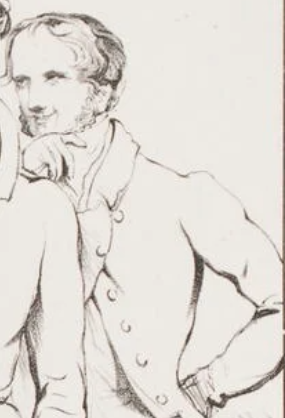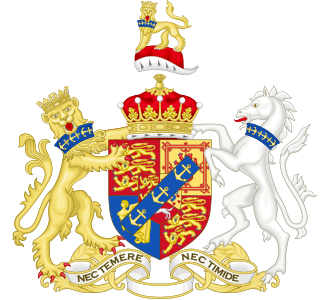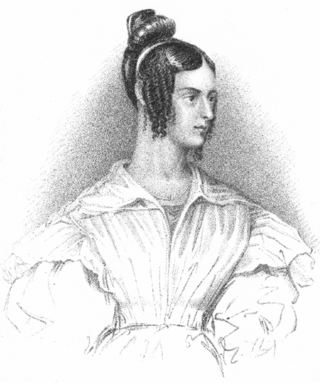
Dorothea Jordan was an Anglo-Irish actress, as well as a courtesan. She was the long-time mistress of Prince William, Duke of Clarence and the mother of 10 illegitimate children by him, all of whom took the surname FitzClarence. She was known professionally as Dorothea Francis and Dorothea Jordan, was informally Dora Jordan, and she commonly was referred to as Mrs Jordan and Mrs FitzClarence.

Earl of Munster was a title created twice, once in the Peerage of Ireland and once in the Peerage of the United Kingdom. The first creation came in 1789 in favour of Prince William, the third son of King George III. He was made Duke of Clarence and St Andrews at the same time. When William succeeded to the throne as King William IV in 1830 the titles merged with the crown.

Lieutenant-General Lord Frederick FitzClarence, GCH was a British Army officer and the third illegitimate son of King William IV by his mistress Dorothea Jordan.

George Gordon, 9th Marquess of Huntly,, styled Lord Strathavon until 1795 and known as The Earl of Aboyne from 1795 to 1836, was a Scottish peer and soldier.

George Augustus Frederick FitzClarence, 1st Earl of Munster, was an English peer and soldier.

Charles Gordon, 10th Marquess of Huntly, styled Lord Strathavon from 1794 to 1836 and Earl of Aboyne from 1836 to 1853, was a Scottish peer, politician, courtier, and cricketer. He was a Member of Parliament, first as a Tory (1818–1830) and then a Whig.

William FitzClarence, 2nd Earl of Munster,, styled Viscount FitzClarence from 1831 to 1842, was a British peer. He was named after his grandfather, King William IV.

Rear-Admiral Lord Adolphus FitzClarence was a British Royal Navy officer and illegitimate son of Prince William, the future William IV, and his mistress Dorothea Jordan. FitzClarence joined the navy in 1813. In the following year he joined a fourth rate which saw service in the War of 1812, including in the unsuccessful blockade and chase of USS Constitution. FitzClarence saw frequent service in the Mediterranean Sea. Coming under the patronage of Rear-Admiral Sir Thomas Fremantle, FitzClarence received further naval education from Commander William Henry Smyth and served in the Ionian Islands upholding British neutrality in the Greek War of Independence.
Fitz was a patronymic indicator used in Anglo-Norman England to help distinguish individuals by identifying their immediate predecessors. Meaning "son of", it would precede the father's forename, or less commonly a title held by the father. In rare cases, it formed part of a matronymic to associate the bearer with a more prominent mother. Convention among modern historians is to represent the word as fitz, but in the original Norman French documentation, it appears as fiz, filz, or similar forms, deriving from the Old French noun filz, fiz, meaning "son of", and ultimately from Latin filius (son). Its use during the period of English surname adoption led to its incorporation into patronymic surnames, and at later periods this form was adopted by English kings for the surnames given some of their recognized illegitimate children, and by Irish families when anglicizing their Gaelic patronymic surnames.

Geoffrey George Gordon FitzClarence, 3rd Earl of Munster, DSO, known as Lord Tewkesbury 1870–1901, was a British peer, and the great-grandson of King William IV by his mistress Dorothea Jordan.

Sophia Sidney, Baroness De L'Isle and Dudley was the eldest illegitimate daughter of William IV of the United Kingdom and his longtime mistress Dorothea Jordan. She was married to Philip Sidney, 1st Baron De L'Isle and Dudley, and had four surviving children. Shortly before her death in 1837, she served as State Housekeeper in Kensington Palace.

Amelia Cary, Viscountess Falkland, was a British noblewoman. She was born the fifth illegitimate daughter of William IV of the United Kingdom by his long-time mistress Dorothea Jordan. Amelia had four sisters and five brothers, all surnamed FitzClarence. Soon after their father became monarch, the FitzClarence children were raised to the ranks of younger children of a marquess. A granddaughter of George III, Amelia was named after her aunt Princess Amelia.

Anthony Charles FitzClarence, 7th Earl of Munster, was the last Earl of Munster, Viscount FitzClarence and Baron Tewkesbury. The Earl of Munster was the last of the male line of FitzClarences that began with King William IV and his mistress, the comic actress Dorothea Jordan.
Agnes Duff, Countess Fife, was an Irish-Scottish aristocrat.
Admiral Lord John Frederick Gordon Hallyburton, GCH was a Scottish naval officer and Member of Parliament.

Aubrey FitzClarence, 4th Earl of Munster was an English aristocrat and a great-grandson of King William IV by his mistress Dorothea Jordan.

Wilhelmina FitzClarence, Countess of Munster was a British peeress and novelist. Her mother, Lady Augusta FitzClarence, was an illegitimate daughter of William IV of the United Kingdom; Wilhelmina, also known as Mina, was born the day after William's succession as monarch. She travelled as a young girl throughout Europe, visiting the courts of France and Hanover. In 1855, Mina married her first cousin William FitzClarence, 2nd Earl of Munster; they would have nine children, including the 3rd and 4th Earls of Munster.

Lady Augusta Gordon was a British noblewoman. Born the fourth illegitimate daughter of William IV of the United Kingdom by his long-time mistress Dorothea Jordan, she grew up at their Bushy House residence in Teddington. Augusta had four sisters and five brothers all surnamed FitzClarence. Soon after their father became monarch, the FitzClarence children were raised to the ranks of younger children of a marquess.

Lord Augustus FitzClarence, was the youngest illegitimate son of William IV of the United Kingdom and his long-time mistress Dorothea Jordan. Like his siblings, he had little contact with his mother after his parents separated in 1811.

William Harry Hay, 19th Earl of Erroll, styled Lord Hay between 1823 and 1831, and Lord Kilmarnock from 1831 to 1846, was a Scottish peer.
















